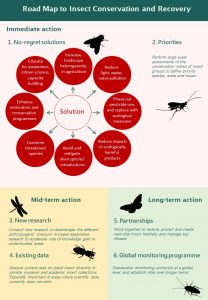by Renate Sander-Regier

Even a small garden, like this one at Hilson Public School, filled with a variety of native plants, can provide food and habitat for pollinators.
For years, researchers and journalists have been pointing to the dramatic loss of insects around the world (see links below). But insect decline has not entered into public discussion as much as other global and environmental phenomena – likely for a complex combination of reasons articulated by the late Stephen Kellert, who devoted much of his career to studying the intricate links between humanity and the natural world (see Values and perceptions).
In the past year, however, plummeting global insect populations have attracted increasing attention, and rightly so, since this multitude of diverse life forms plays critical roles in keeping the planet habitable – from pollination and seed dispersal, to nutrient cycling, pest control, decomposition, and more (see What is the importance of insects in the ecosystem).
Some of the most recent articles, published by groups of experts in January and February of this year, provide descriptions of global insect decline and offer solutions that involve civil society (all of us!), land-users, and policy/decision-makers operating
- in various sectors, including agriculture, forestry, mining, urban planning/management
- in diverse environments, including forests, grasslands, agricultural landscapes, and urban and suburban areas
- at various scales
- from micro-habitats and landscapes, to regional and global expanses
- from immediate actions, to mid- and long-term measures
The scope of the information in the articles is mind-boggling, but the summaries are helpful. And the overall tone is encouraging. There is much we can do, and we can make a big difference if we take immediate action.
Ideas to help insects
From: Scientists warn humanity about worldwide insect decline, and suggest ways to recognise and avert its consequences. See also, full article (open access). |
 In Researchers united on international road map to insect recovery, the authors offer a “road map to insect conservation and recovery,” with immediate, mid-term, and long-term actions (click on the image at the right for a better view). See also, full article (gated).
In Researchers united on international road map to insect recovery, the authors offer a “road map to insect conservation and recovery,” with immediate, mid-term, and long-term actions (click on the image at the right for a better view). See also, full article (gated).
We, WPP-PPS members, are all in there, participating as global citizens and consumers, but contributing to solutions as individuals, groups, and organizations concerned about the plight of wild pollinators, and part of a network seeking to support wild pollinators – and, by extension, other insects.
What we are doing is important. What more can we do? How can we improve what we are already doing? We will have some of those discussions at our 2nd annual Wild Pollinator Partners-Partenaires des pollinisateurs sauvages colloquium on 8 March 2020. Join us there.
More information
To learn more about what the experts are saying about global insect decline and solutions, here are some links.
- What’s causing the sharp decline in insects, and why it matters
- Plummeting insect numbers “threaten collapse of nature”
- As insect populations decline, scientists are trying to understand why
- Light pollution is key “bringer of insect apocalypse”
- Why are insects in decline, and can we do anything about it?
- How to avoid the insect apocalypse: it might not be easy, but it’s eminently possible